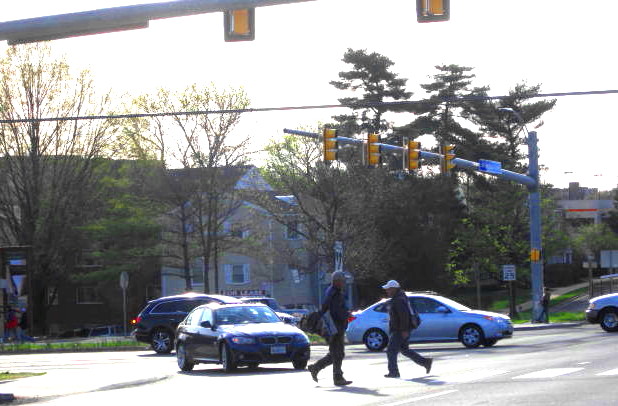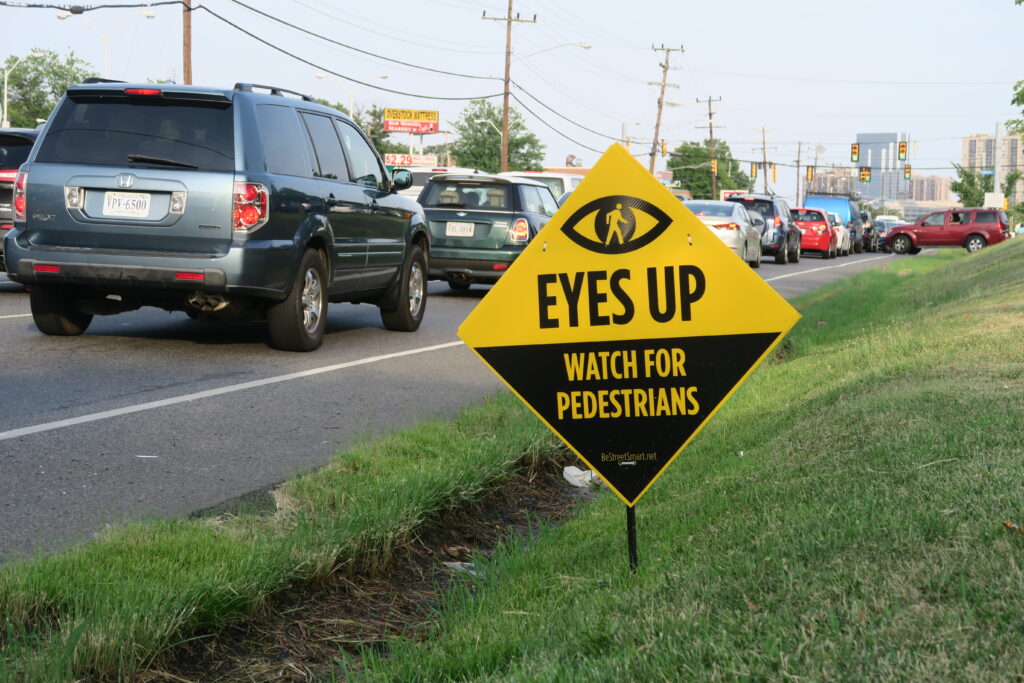Transportation officials talk safety

Improving safety on the region’s busiest roadways requires retrofitting an infrastructure built decades ago, cooperation among jurisdictions, and changing drivers’ mindsets.
Those were the key points from a discussion among regional transportation leaders at a recent webinar hosted by the Schar School of Policy and Government at George Mason University.
Annual traffic fatalities in Virginia have gone up from 703 in 2014 to 968 in 2021.
That isn’t only due to the pandemic, said Nick Donohue, a former Virginia deputy secretary of transportation. The numbers have been going up steadily since 2014. The pandemic just exacerbated the existing trend.
Traffic deaths are also rising nationally. There were 42,900 fatalities in 2021, a 10 percent increase from 2020.
Retrofitting streets
The Fairfax County Department of Transportation is working on retrofitting certain corridors – Route 7, Route 50, and Route 1 – that were developed in the 1960s without a lot of pedestrian infrastructure and where there is now significant density, said FCDOT Director Tom Biesiadny.
Capital projects in the works for those areas include widening sidewalks, repainting crosswalks, and installing signals with “leading pedestrian intervals,” which give pedestrians a head start.
“The new infrastructure bill could allow us to get these things done faster,” Biesiadny said.
The big issue is money, he said. “Retrofitting a built environment is much more expensive than starting from scratch.” That’s because of all the utilities hidden under sidewalks and roads.
FCDOT hired Street Simplified to record videos at 70 busy, complicated intersections for 24 hours. They identified near misses and potential actions to improve safety.

“We’re trying to retrofit an infrastructure designed for cars,” said David Snyder, a member of the Falls Church City Council who serves on the Northern Virginia Transportation Commission.
“Public opinion has evolved in a fairly dramatic way,” Snyder said. “The public now wants more of a focus on pedestrians and bicyclists. We’re shifting to a more inclusive and equitable approach.”
Changing the mindset
According to Biesiadny, Fairfax County is installing additional signage letting drivers know pedestrians have the right of way. The goal is to “jar people out of their mindset.”
Pedestrian mindsets also need to change, he added. They need to understand the shortest distance is not always the safest.
Many residents grew up in a suburban auto-centric environment, he said. “We had knockdown drag-out fights on replacing parking with bike lanes.” Once implemented, however, the complaints died down.
Related story: VDOT pursues safety improvements for Route 7 in Culmore
People are recognizing the community is changing, Biesiadny said. During the pandemic, people spending more time walking around their neighborhoods noticed that many sidewalks don’t connect. The number of requests to address those gaps “went up significantly.”
Communications and messaging are key, said Christine Baker, a planner with Arlington County. “There are a lot of things we can’t engineer our way out of,” such as changing behavior around speeding and distracted driving.
Developers also need to be involved, she said, noting that Arlington is working on getting developers to submit site plans that address safety.
Regional cooperation
The Council of Government’s Transportation Planning Board passed a resolution in 2020 calling for a regional commitment to safety issues.
They prioritized driving behavior, focusing on the use of seatbelts – front and rear – reducing speed, and clamping down on impaired and distracted driving, Snyder noted.
“If you do something regionally, it saves on money and reduces administrative burdens,” said Jerry Roche, an official with the Federal Highway Administration’s Office of Safety. “There is strength in numbers,” and that makes it easier for elected officials to take unpopular actions, like reducing speed limits.
Regional collaboration is important to achieve consistency, as people cross jurisdictions every day, Baker added.
The state’s role
Snyder calls for the state to give local agencies more authority to enforce traffic safety laws and more funding to retrofit transportation infrastructure.
State legislation passed in 2021 allows localities to reduce speeds to 25 mph in business and residential districts – but not below 15 mph.
Virginia now allows speed cameras in school zones, Snyder noted, but that needs to be expanded to other areas. Speed cameras are very effective in reducing crashes, Roche said. Because they’re always on, they’re especially helpful in places with a shortage of police officers.
He called for clarification of the state law that requires vehicles to stop for pedestrians. Right now, there’s some ambiguity in how that rule is interpreted.
Virginia should ban open containers, Donohue added. Virginia is one of the few states “where you can drive around with an open bottle of whiskey in a cup holder.” The state also doesn’t have a primary seatbelt law, meaning the police can’t pull you over for not wearing a seatbelt.
“Those are proven laws that can prevent tragedies,” he said.
Wearing seatbelts in the back seat can save lives, Roche said. There have been crashes where people unbelted in the back seat were hurled forward, killing people with seatbelts on in the front seat.
Federal actions
The bipartisan infrastructure bill passed by Congress this year includes $1 billion for the new Safe Streets and Roads for All program. Local agencies can apply for funds, but states cannot.
The U.S. Department of Transportation has a new safety strategy with the goal of zero deaths, Roche reported. It’s a safe-system approach with five elements: safe road users, safe vehicles, safe speeds, safe roads, and post-crash care.

The federal government is putting an increased emphasis on pedestrians and bicyclists, he said. Congress is requiring DOT to report on the Complete Streets design model, which supports multimodal transportation.
DOT is also developing guidelines for Vulnerable Road User Assessments that encourage states to discuss road safety with local agencies and nonprofits. States must complete these assessments by November 2023.
Snyder said it’s extremely difficult to get grant money for sidewalks and other relatively cost-effective spot improvements. “The paperwork makes it much more difficult, so we’re using local funds,” added Biesiadny.
According to Roche, DOT is streamlining its rules to reduce those obstacles.
A systemic approach
Much of the work going on in Northern Virginia involves a systemic approach that looks at all road users, with a special emphasis on pedestrians.
In May, the Fairfax County Board of Supervisors adopted Safe Streets for All, a plan for reducing deaths and crashes for pedestrians, bicyclists, and users of other forms of active transportation.
The board also approved $100 million for the next six years, including $30 million for the current year, to make streets safer, Biesiadny said.
Arlington County adopted Vision Zero in 2020, with the goal of getting to zero traffic deaths by 2030.
According to Baker, the program manager for Vision Zero, the initiative has these goals:
- ensuring safety from a multimodal perspective;
- putting safety first on all plans and projects, not just transportation projects;
- collaboration with schools, police, and other community partners;
- transparency and accountability on progress;
- basing decisions on data and facts; and
- prioritizing equity by focusing on high-need areas.
Arlington is using a data-driven approach to determine which projects get the highest priority, Baker said. The analysis considers the number of crashes, giving a higher weight to crashes resulting in fatalities and serious injury and near misses.
A systemic approach – that focuses on places with a lot of crashes – is most effective, Roche said. “It’s like going to the doctor for an annual checkup, where they ask you to fill out a form with your family health history and personal health habits and check your weight and height before the doctor sees you. They don’t wait until you have chest pain.”


Thank god this is being recognized by the county and the state, I literally saw someone get hit by a car this month and I ran to them, as a first responder, and I believe I saved their life with getting emergency services to get there in 5mins. Everyone in the DMV area is always in a rush and it sucks cause I really just care about safety for people in cars or on the streets like children, adults, elderly, and animals, also my own as a pedestrian too. I know ill get to my destination eventually, but I’m not gunna put someone else life at risk and speed all over the place just because I’m running a little bit late. Maybe I say this cause I’ve seen people drive around the area like it’s the fast & the furious movies, but at least I know I do my part by advocating to slow down.